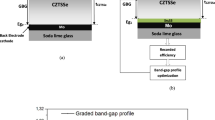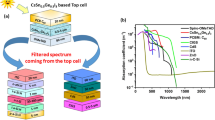Abstract
Lead-free perovskite (LFP) materials are leading the photovoltaic (PV) market due to their nontoxic nature and good optoelectronic properties. It also increases the reliability and stability of perovskite solar cells (PSC). However, the performance of such materials is not upto the mark due to some inherent losses. Therefore, in this paper, the concept of a two-terminal monolithic tandem solar cell is utilized to mitigate the non-absorbed photon loss of the lead-free wide bandgap (1.8 eV) halide (WBH) PSC. For efficient absorption of top cell filtered spectrum, bottom cell has been designed with CZTSSe (1.1 eV) as active layer and tin (II) sulfide (Sn2S3) as back surface layer. Both LFP based top cell and CZTSSe based bottom cell have been analyzed under standalone conditions. Thereafter, to analyse the tandem configuration top cell is illuminated with AM1.5 G spectrum while for the bottom cell the unabsorbed spectrum by top cell has been used. To account for the mandate requirement of tandem cell designing current matching approach is utilized and LFP-CZTSSe tandem solar cell has been designed to deliver an efficiency of 16.6%. The obtained result shows the best current matching condition at 380 nm thick LFP and 550 nm thick CZTSSe, respectively, with a short circuit current density (JSC) of 14.9 mA/cm2. The final tandem device showed the power conversion efficiency of 16.6% with an open-circuit voltage (VOC) of 1.7 V. The obtained conversion efficiency is higher compared to till date experimental standalone conversion efficiency of LFP solar cells. Therefore, the proposed LFP-CZTSSe tandem solar cell would be a strong candidate in the PV industry delivering high efficiency at a cheap cost.





Similar content being viewed by others
Availability of data and materials
The data that support the findings of this study shall be made available from the corresponding author upon reasonable request.
References
Adewoyin, A.D., Olopade, M.A., Oyebola, O.O., Chendo, M.A.: Development of CZTGS/CZTS tandem thin film solar cell using SCAPS-1D. Optik 176, 132–142 (2019)
Bello, I.T., Awodele, M.K., Adedokun, O., Akinrinola, O., Awodugba, A.O.: Modeling and simulation of CZTS-perovskite sandwiched tandem solar cell. Turk. J. Phys. 42(3), 321–328 (2018)
Burdick, J., Glatfelter, T.: Spectral response and IV measurements of tandem amorphous-silicon alloy solar cells. Solar Cells (1986). https://doi.org/10.1016/0379-6787(86)90129-8
Burgelman, M., Verschaegen, J., Degrave, S., Nellet, P.: Modeling thin film PV devices. Progress Photovolt. Res. Appl. (2004)
Burgelman, M., Verschraegen, J., Minnaert, B., Marlein, J.: Numerical simulation of thin film solar cells: practical exercises with SCAPS. In: Proceedings of NUMOS (Int. Workshop on Numerical Modelling of Thin Film Solar Cells, Gent (B), Gent. 2007. UGent & Academia Press. (2007)
Dong, H., et al.: Improving electron extraction ability and device stability of perovskite solar cells using a compatible PCBM/AZO electron transporting bilayer. Nanomaterials 8(9), 720 (2018)
Eperon, G.E., et al.: Perovskite-perovskite tandem photovoltaics with optimized band gaps. Science 354(6314), 861–865 (2016)
Gao, H., Qin, C., Zhang, H., Wu, S., Su, Z.-M., Wang, Y.: Theoretical characterization of a typical hole/exciton-blocking material bathocuproine and its analogues. J. Phys. Chem. A 112(38), 9097–9103 (2008)
Gohri, S., Madan, J., Pandey, R., Sharma, R.: Performance analysis for SnS-and Sn2S3-based back surface field CZTSSe solar cell: a simulation study. J. Electron. Mater. 50(11), 6318–6328 (2021b)
Gohri, S., Sharma, S., Pandey, R., Madan, J., Sharma, R.: Influence of SnS and Sn2S3 based BSF layers on the performance of CZTSSe solar cell. In: 2020 47th IEEE Photovoltaic Specialists Conference (PVSC) (2020). Doi: https://doi.org/10.1109/PVSC45281.2020.9300852.
Gohri, S., Madan, J., Pandey, R., Sharma, R.: Performance analysis for SnS-and Sn2S3-based back surface field CZTSSe solar cell: a simulation study. J. Electr. Mater., 1–11 (2021a)
Gohri, S., Madan, J., Pandey, R., Sharma, R.: Assessment of WSe 2 based BSF layer on CZTSSe solar cell using SCAPS-1D. In: 2021c 48th IEEE Photovoltaic Specialists Conference (PVSC), IEEE, pp. 2020–2022 (2021c)
Gupta, G.K., Dixit, A.: Theoretical studies of single and tandem Cu2ZnSn (S/Se) 4 junction solar cells for enhanced efficiency. Opt. Mater. 82, 11–20 (2018)
Hao, F., Stoumpos, C.C., Chang, R.P., Kanatzidis, M.G.: Anomalous band gap behavior in mixed Sn and Pb perovskites enables broadening of absorption spectrum in solar cells. J. Am. Chem. Soc. 136(22), 8094–8099 (2014)
Islam, M.T., et al.: Investigation of CsSn 0.5 Ge 0.5 I 3-on-Si tandem solar device utilizing SCAPS simulation. IEEE Trans. Electron Devices 68(2), 618–625 (2021)
Kim, K., et al.: Nanoscale optical and photoresponsive electrical properties of P3HT and PCBM composite nanowires. Org. Electron. 12(10), 1695–1700 (2011)
Kim, K., et al.: Simulations of chalcopyrite/c-Si tandem cells using SCAPS-1D. Sol. Energy 145, 52–58 (2017)
Kumar, A., Singh, S., Mohammed, M.K.A., Shalan, A.E.: Computational modelling of two terminal CIGS/Perovskite tandem solar cells with power conversion efficiency. Eur. J. Inorg. Chem 1, 12 (2021)
Madan, J., Shivani, R.P., Sharma, R.: Device simulation of 17.3% efficient lead-free all-perovskite tandem solar cell. Sol. Energy 197, 212–221 (2020a)
Madan, J., Pandey, R., Sharma, R.: Device simulation of 17.3% efficient lead-free all-perovskite tandem solar cell. Sol. Energy 197, 212–221 (2020b)
Meyer, E., Mutukwa, D., Zingwe, N., Taziwa, R.: Lead-free halide double perovskites: a review of the structural, optical, and stability properties as well as their viability to replace lead halide perovskites. Metals 8(9), 667 (2018)
Minbashi, M., Ghobadi, A., Ehsani, M., Dizaji, H.R., Memarian, N.: Simulation of high efficiency SnS-based solar cells with SCAPS. Sol. Energy 176, 520–525 (2018)
Omrani, M.K., Minbashi, M., Memarian, N., Kim, D.-H.: Improve the performance of CZTSSe solar cells by applying a SnS BSF layer. Solid-State Electron. 141, 50–57 (2018)
Pandey, R., Chaujar, R.: Numerical simulations: Toward the design of 27.6% efficient four-terminal semi-transparent perovskite/SiC passivated rear contact silicon tandem solar cell. Superlattices Microstruct. 100, 656–666 (2016)
Pandey, R., Singla, A., Madan, J., Sharma, R., Chaujar, R.: Toward the design of monolithic 23.1% efficient hysteresis and moisture free perovskite/c-Si HJ tandem solar cell: a numerical simulation study. J. Micromech. Microeng. 29(6), 064001 (2019)
Sharma, S., Gohri, S., Pandey, R., Madan, J., Sharma, R.: Device simulation of Poly (3-Hexylthiophene) HTL based single and double halide perovskite solar cells. In: 2020 47th IEEE Photovoltaic Specialists Conference (PVSC) IEEE, pp. 2327–2330 (2020)
Shivani, J. Madan, R. Pandey, Sharma, R.: Designing of CZTSSe based SnS thin film solar cell for improved conversion efficiency: a simulation study with SCAPS. In: 2019 46th IEEE Photovoltaic Specialists Conference (PVSC). pp. 0193–0195 (2019)
Shockley, W., Queisser, H.J.: Detailed balance limit of efficiency of p-n junction solar cells. J. Appl. Phys. 32(3), 510–519 (1961)
Wang, W., et al.: Device characteristics of CZTSSe thin-film solar cells with 12.6% efficiency. Adv. Energy Mater. 4(7), 1301465 (2014)
Yang, K.-J., et al.: A band-gap-graded CZTSSe solar cell with 12.3% efficiency. J. Mater. Chem. A 4(26), 10151–10158 (2016)
Zhao, D., et al.: Low-bandgap mixed tin–lead iodide perovskite absorbers with long carrier lifetimes for all-perovskite tandem solar cells. Nat. Energy 2(4), 1–7 (2017)
Acknowledgements
The authors are grateful to Dr. Marc Burgelman and his staff, at the University of Gent, Belgium, for providing the open-source SCAPS-1D simulator.
Funding
No funding was received for this work.
Author information
Authors and Affiliations
Contributions
SG: Writing, Software, Data curation, Original draft. JM: Conceptualization, Methodology, Software, Validation, Formal analysis, Review & editing. RP: Writing, Resources, Formal analysis, Review & editing, Supervision. RS: Review & editing, Resources, Supervision.
Corresponding authors
Ethics declarations
Competing interests
The authors declare that they have no potential conflict of interest, financially or non-financially, directly or indirectly related to the work under consideration.
Ethical approval
Not applicable.
Additional information
Publisher's Note
Springer Nature remains neutral with regard to jurisdictional claims in published maps and institutional affiliations.
This article is part of the Topical Collection on Recent Advances of Advanced Functional Materials for Optics, Lasers and Photovoltaics Applications, Guest edited by Oksana Krupka, Anna Zawadzka, Hassane Erguig, Alexander Quant and Bouchta Sahraoui.
Rights and permissions
Springer Nature or its licensor (e.g. a society or other partner) holds exclusive rights to this article under a publishing agreement with the author(s) or other rightsholder(s); author self-archiving of the accepted manuscript version of this article is solely governed by the terms of such publishing agreement and applicable law.
About this article
Cite this article
Gohri, S., Madan, J., Pandey, R. et al. Design and analysis of lead-free perovskite-CZTSSe based tandem solar cell. Opt Quant Electron 55, 171 (2023). https://doi.org/10.1007/s11082-022-04381-5
Received:
Accepted:
Published:
DOI: https://doi.org/10.1007/s11082-022-04381-5




